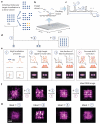Optical imaging of individual biomolecules in densely packed clusters
- PMID: 27376244
- PMCID: PMC5014615
- DOI: 10.1038/nnano.2016.95
Optical imaging of individual biomolecules in densely packed clusters
Abstract
Recent advances in fluorescence super-resolution microscopy have allowed subcellular features and synthetic nanostructures down to 10-20 nm in size to be imaged. However, the direct optical observation of individual molecular targets (∼5 nm) in a densely packed biomolecular cluster remains a challenge. Here, we show that such discrete molecular imaging is possible using DNA-PAINT (points accumulation for imaging in nanoscale topography)-a super-resolution fluorescence microscopy technique that exploits programmable transient oligonucleotide hybridization-on synthetic DNA nanostructures. We examined the effects of a high photon count, high blinking statistics and an appropriate blinking duty cycle on imaging quality, and developed a software-based drift correction method that achieves <1 nm residual drift (root mean squared) over hours. This allowed us to image a densely packed triangular lattice pattern with ∼5 nm point-to-point distance and to analyse the DNA origami structural offset with ångström-level precision (2 Å) from single-molecule studies. By combining the approach with multiplexed exchange-PAINT imaging, we further demonstrated an optical nanodisplay with 5 × 5 nm pixel size and three distinct colours with <1 nm cross-channel registration accuracy.
Figures






Comment in
-
Super-resolution optical microscopy: Seeing the smaller picture.Nat Nanotechnol. 2016 Sep 7;11(9):737-8. doi: 10.1038/nnano.2016.165. Nat Nanotechnol. 2016. PMID: 27599880 No abstract available.
References
-
- Hell SW, Wichmann J. Breaking the diffraction resolution limit by stimulated emission: stimulated-emission-depletion fluorescence microscopy. Optics Letters. 1994;19 - PubMed
-
- Klar TA, Hell SW. Subdiffraction resolution in far-field fluorescence microscopy. Optics letters. 1999;24:954–956. - PubMed
-
- Gustafsson MG. Surpassing the lateral resolution limit by a factor of two using structured illumination microscopy. Journal of microscopy. 2000;198:82–87. - PubMed
-
- Betzig E, et al. Imaging intracellular fluorescent proteins at nanometer resolution. Science (New York, N.Y.) 2006;313:1642–1645. - PubMed
Publication types
MeSH terms
Substances
Grants and funding
LinkOut - more resources
Full Text Sources
Other Literature Sources

